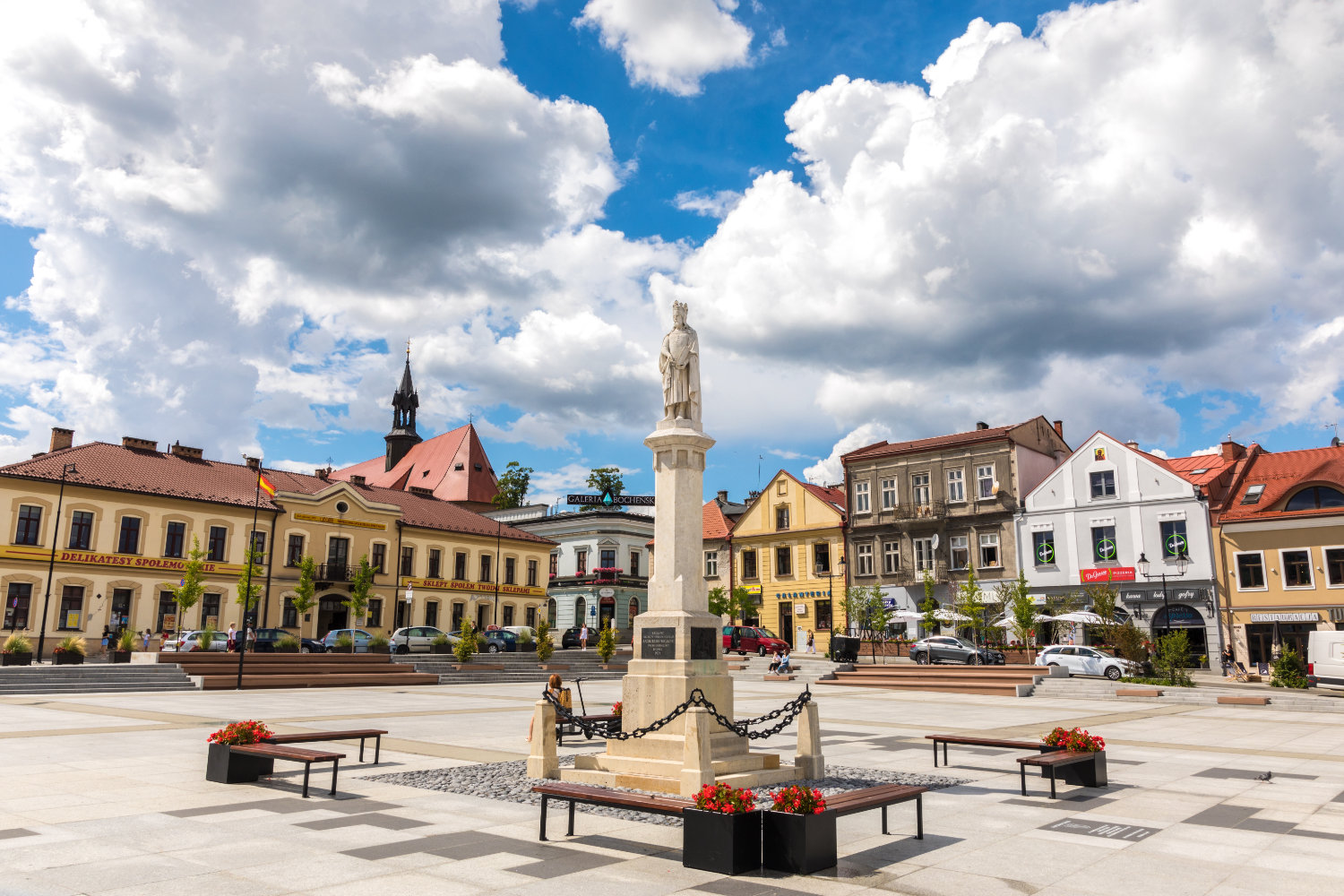
Na środku Rynku stoi pomnik Kazimierza Wielkiego wzniesiony w 1871 roku na fali patriotycznego ożywienia związanego z odkryciem w katedrze wawelskiej szczątków monarchy.
Pomysł zbudowania pomnika w Bochni wyszedł z kręgu Jana Matejki, który w 1869 roku był autorem rysunków wykonanych w wawelskiej krypcie. Pod wpływem sugestii wielkiego malarza jego szwagier – ówczesny marszałek powiatu Leonard Serafiński powziął ambitny plan uczczenia pamięci wielkiego króla. Propozycja została w Bochni dobrze przyjęta, gdyż miejscowa tradycja wiązała z Kazimierzem Wielkim jeden z najpomyślniejszych okresów w dziejach miasta. Do realizacji tej idei Serafiński pozyskał burmistrza Romana Niwickiego. 24 X 1870 roku rada miejska podjęła następującą uchwałę: „Na głównym Rynku Bochni wystawiony ma być pomnik na cześć Króla Polskiego JMĆ Kazimierza Wielkiego, któren był ojcem i wielkim dobrodziejem miasta Bochni”. Postanowiono, że koszty pokryje budżet miasta i datki obywateli.
Pomnik jest dziełem rzeźbiarza krakowskiego Walerego Gadomskiego (1833-1911), który po udziale w powstaniu styczniowym zamieszkał u właścicieli Szczurowej Kępińskich – znanych mecenasów literatury i sztuki. Matejko, który zaproponował Gadomskiego jako wykonawcę monumentu, wykonał kilka szkiców oraz osobiście doglądał postępów przy jego realizacji. Należy dodać, że Gadomski w latach 1877-1889 był profesorem rzeźby w krakowskiej Szkole Sztuk Pięknych. Był zarazem artystą uznanym, o pokaźnym dorobku (pomniki Mikołaja Kopernika w Akademii Umiejętności w Krakowie, Franciszka Karpińskiego w Kołomyi, Artura Grottgera we Lwowie, Zygmunta Augusta i Jana III Sobieskiego w Ogrodzie Strzeleckim w Krakowie oraz wielu innych). Pomnik wykonał z wapienia pińczowskiego. Ponad dwumetrowej wysokości rzeźbę króla trzymającego statuty wiślickie w lewej ręce umieścił na neogotyckiej kolumnie. Na piedestale – kamienne płaskorzeźby przedstawiające nadanie wspomnianego dokumentu, założenie Akademii Krakowskiej, godło polskie oraz napis; „Królowi chłopków, opiekunowi miast Kazimierzowi Wielkiemu swemu dobroczyńcy, Bochnia 1871”.

Uroczystość odsłonięcia pomnika odbyła się 29 maja 1871 roku.
Oprócz wielu mieszkańców Bochni i powiatu zgromadziła także licznych gości z innych miast galicyjskich, a nawet zaboru pruskiego, przybyli też Gadomski i Matejko. – „Gdy tak Kraków, który w łonie swoim mieści grobowce wszystkich niemal królów naszych, obojętnem milczeniem pokrywał niedbalstwo swoje – mała, z górniczych osad złożona mieścina Bochnia, żywą protestacyą upomniała się o cześć swojego króla i honor narodowy. Nie radzono się wiele, ale żywo i energicznie postawiono projekt wzniesienia pomnika (…) i zaraz myślą szlachetną czyn wcielono” pisała poznańska „Sobótka”, która zamieściła drzeworyt ilustrujący uroczysty dzień na bocheńskim Rynku.

W 1933 roku, w związku z uroczystymi obchodami 600-lecia wstąpienia na tron Kazimierza Wielkiego, dokonano renowacji obiektu zmieniając także ogrodzenie. Zwiększono liczbę kamiennych słupków połączonych kutym, ozdobnym łańcuchem. Od 1964 roku, czyli od czasu przebudowy Rynku, pomnik przez następne ćwierćwiecze miał zupełnie inny wygląd. Pierwotny cokół zastąpiono bezstylowym obeliskiem, kamienne płaskorzeźby- odlewami z brązu. Usunięto słupki i łańcuchy przenosząc je na grób Leonarda Serafińskiego znajdujący się na Cmentarzu Komunalnym przy Orackiej. Obok pomnika zaś założono skwer. Na szczęście w 1988 roku, kiedy rzeźbę poddano konserwacji, zrekonstruowano cokół według pierwotnego wzoru. Oryginalny kapitel można obejrzeć obecnie na dziedzińcu muzeum. Wspomniana rekonstrukcja objęła też słupki i łańcuchy, lecz pozostawiono pewne elementy dotychczasowego otoczenia (np. skwerek), co powoduje dysonans kompozycyjny.









